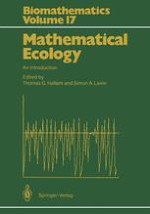1986 | OriginalPaper | Buchkapitel
Biophysical Ecology: An Introduction to Organism Response to Environment
verfasst von : Louis J. Gross
Erschienen in: Mathematical Ecology
Verlag: Springer Berlin Heidelberg
Enthalten in: Professional Book Archive
Aktivieren Sie unsere intelligente Suche, um passende Fachinhalte oder Patente zu finden.
Wählen Sie Textabschnitte aus um mit Künstlicher Intelligenz passenden Patente zu finden. powered by
Markieren Sie Textabschnitte, um KI-gestützt weitere passende Inhalte zu finden. powered by
The direct effects of environmental factors on the physiology and behavior of individuals comprise the building blocks upon which ecology is based. In the reductionist view (Gates, 1980), all ecological interactions may be carried down to the level of the cell and individual through careful analysis of physical and chemical processes. This approach, involving the detailed analysis of the underlying processes in a natural system, is in practice limited by the complexity of biological systems. Interactions may be viewed at levels from the molecular, through tissue, organ, and individual, and beyond to population, community and ecosystem. The viewpoint of biophysical ecology is that general ecological perspectives may be obtained by considering the effects of environments on individuals and that knowledge of processes at this level is critical to understanding the structure of populations and communities. The known results from scientific fields as varied as chemical kinetics, fluid flow, thermodynamics, atmospheric physics, and soil mechanics are applied to structure a cohesive framework for analysing organism response to environmental factors. A great advantage of this framework is that it applies independent of the type of organism, animal or plant, terrestrial, aquatic or arboreal. The same physical principles underly all of nature. In practice, of course, this advantage is ameliorated by the great range of environments which organisms inhabit, each providing its own unique challenges for organism survival.
